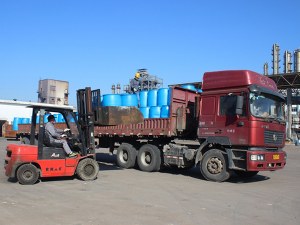Methyltrichlorosilane (M1)
Name: Methyltrichlorosilane
Feature: This product is a colorless transparent liquid. It is the main material of silicone products to produce methyltriethoxysilane and silane crosslinking agent (methyl triethoxysilane and methyltrimethoxysilane), and produce silicon resin, special coatings, building waterproofing agent, and oilfield drilling collapse resistance agent for methyl sodium silicate used in drilling wells on the oil field.
CAS No.: 75-79-6
Technical Data of Methyltrichlorosilane
|
Testing Items |
Testing Standards |
|
Methyltrichlorosilane /% |
≥ 99.5 |
|
Trimethylchlorosilane /% |
≤ 0.05 |
|
Dimethyldichlorosilane /% |
≤ 0.20 |
|
Tetrachlorosilane /% |
≤ 0.01 |
Application of Methyltrichlorosilane
It is mainly used for the production of methyl triethoxysilane, methyl trimethoxysilane, and other crosslinking agents, silicone resin, special coatings, construction waterproofing agent, and oilfield drilling anti-collapse agent (sodium methyl silicate), as well as gas-phase silica and other products.
Silicone materials, including methyl trichlorosilane, are not only as special materials used in military, aviation, aerospace, and other cutting-edge industries, but also widely used in construction, textile, automobile, machinery, electronic and electrical appliances, chemical and light industry, leather and papermaking, medicine and health, etc. To a certain extent, it reflects the development of a country.
Product Appearance of Methyltrichlorosilane
-colorless
-transparent liquid
-no mechanical impurity (Mechanical impurity refers to the precipitation of suspended matter in petroleum or petroleum products that is insoluble in oil and specified solvents, such as mud sand, dust, iron filings, fibers, and certain insoluble salts.)
-have a pungent odor
-easy deliquescence
Production Methods of MethylChlorosilane
There are two production methods of methyl chlorosilane-indirect method and direct method. It was invented by E.G. Rojo in 1940 and is produced by using copper or copper salt as the catalyst to make a direct reaction between methyl chloride and silicon powder at about 300℃. This is a complex non-homogeneous reaction. The resulting mixture mainly contains dimethyldichlorosilane (about 70%), followed by methyl trichlorosilane, trimethylchlorosilane, methyl dichlorosilane, etc. The product can be obtained by distillation. The product is obtained in pure form by distillation. Due to the exothermic nature of the reaction, temperature control is extremely important, and most fluidized bed reactors are now used.
Storage and Transportation of Methyltrichlorosilane
Storage: Stored in a shady, cool, and ventilated place. It should be kept away from kindling and heat sources, avoid direct sunlight.
Transportation: When transported, avoid rain and direct sunshine.
Description of Silane Crosslinking
Silane crosslinking is introduced into polyethylene by a silane coupling agent to increase the strength and aging resistance of polyethylene.
Since its introduction in the late 1960s, silane-based cross-linked polyethylene technology has grown considerably and gained wide application.
There is three main industrial silane crosslinking polyethylene processes: the two-step production process (also known as SioplasE), the one-step production process (also known as MonosilR), and the vinyl silane copolymer process, of which the vinyl silane copolymer process combines many of the advantages of the two-step and one-step processes and has greater advantages, but the cross-linking reactions in all three processes are accomplished by immersing silane-modified polyethylene mixed with a silanol condensation catalyst in warm water or water vapor. However, the cross-linking reaction in all three processes is accomplished by immersing silane-modified polyethylene mixed with a silane condensation catalyst in warm water or water vapor, and the water required for cross-linking is diffused from outside. Due to the non-hydrophilic nature of polyethylene, the diffusion of water in polyethylene is very slow, resulting in very slow cross-linking, and the thicker the wall of the product, the longer the cross-linking time.
Development and Application of Silane Crosslinking
The mechanical properties, heat resistance, chemical resistance, and stress-cracking resistance of polyethylene are largely improved by silane crosslinking, which broadens the range of applications. Silane crosslinking polyethylene is mainly used for the insulation of medium and low-voltage wires and cables, and are also one of its main applications, which can be used as hot and cold water , drinking water , for transporting corrosive gases and liquids in the chemical industry. China encourages and advocates the use of chemical building materials, and the development of cross-linked polyethylene has good market prospects and can create good economic benefits.
There are two main methods of silane crosslinking in practice, one is a two-step method invented by Dow Corning (UK), called the Sioplas method, and the other is a one-step method invented by BICC (British Insulated Cable Company) and Maillefer, called the Monosil method. In recent years, the silane copolymer method has emerged as a result of the attention given to polyethylene products by petrochemical resin manufacturers. The silane crosslinking process of both methods is as follows.
①Sioplas process
② Process of Monosil method
The silane copolymer method is actually a variant of the Sioplas method. The difference is that the polyethylene graft is not prepared by reaction extrusion, but by adding a second component (silane) to the copolymerization of ethylene during the polymerization of ethylene to obtain copolymerized ethylene? Silane copolymer (A material), cross-linking catalyst and other auxiliary additives and then by mixing equipment to make catalytic masterbatch (B material), and then according to A, B two-component products factory.
The Sioplas method is a two-step process in which two extruders are used to produce the PE silane graft and the catalytic masterbatch in advance, and then the two materials are mixed in a certain ratio to produce the cross-linked PE pipe on a third extruder. The peroxide used for silane crosslinking is used as an initiator, and the dosage is equivalent to about 1/?20 (0.1%) of the dosage in the peroxide cross-linking method. The silane graft is generally dry-mixed with a 5% catalytic masterbatch and extruded into molded products; the products are then cross-linked in a high-temperature water bath (60-95°C). The storage period of the silane graft in this method is short because the cross-linking reaction can proceed slowly even in the absence of the catalyst.
The Monosil method is a one-step process, which is characterized by the direct addition of silane, peroxide, and catalyst to the same extruder. The crosslinking degree of the products produced by the one-step process can be improved compared to the two-step process.
As one of silicone suppliers, we can offer different kinds of related products for sale, if you have needs, please leave us a message.
Persona a contactar : Cheng Doris, 05708598517
Buen trato: comprar del vendedor
Por favor, lea nuestras condiciones de uso. También puede visitar nuestras preguntas frecuentes y ver nuestra información sobre los riesgos relacionados con la falsificación.
|
Esta página es acerca de los importadores y exportadores de Methyltrichlorosilane (M1) Buscar en la categoria : Búsqueda/compra Buscar en la categoria : methyltrichlorosilane |
Tuesday 23 December 2025
Cantidad : 5000 - Precio : 18,00 €
LLEGADA BOXERS TRIPACKS CALVIN KLEIN OMBRE Todos nuestros productos son almacén disponible y directo. MYLOOKDISCOUNT es de más de 20.000 productos transformados CADA MES. Estamos especializados en la venta al por mayor y al por menor de prendas de vestir de marca desde 2005. Comprar...
webshop
- newlookdiscount
- 13300 - salon de provence
- 09 72 31 67 88
Tuesday 23 December 2025
Cantidad : 3 conteneu - Precio : 1,00 - 2,50 euros pa
- DESCRIPTION DU PRODUIT: Haute qualité de chaussures classées dans 3 catégories: Crème, A, et B 2. QUALITÉS: - Qualité Crème: Qualité supérieure de chaussures Presque nefs sans presque use et parfait état de conservation classés par gendre, type, etc. et conditionnés dans sacs de 23/25 Kg...
Euroafrique Recycling SL
- euroafritex
- 03203 - Alicante
- 965020177
- +34 9 65 02 01 77
- +34 6 32 82 94 61
Monday 25 March 2013
Cantidad : 12 - Precio : 62,00 €
Importador vende sanzas o carimbas: 12 cm de diámetro llaves metálicas, cara inferior de madera exótica y el fondo de medio coco. Muy buen sonido. Se venden en paquetes de 25 piezas: 62,50 € el lote oséa 2,50 € por pieza. Mínimo comprar un lote. Si esta propuesta le gusta, solo...
OUTRE MERS
- outremers
- 17110 - SAINT GEORGES DE DIDONNE
- +33 6 81 16 68 53










